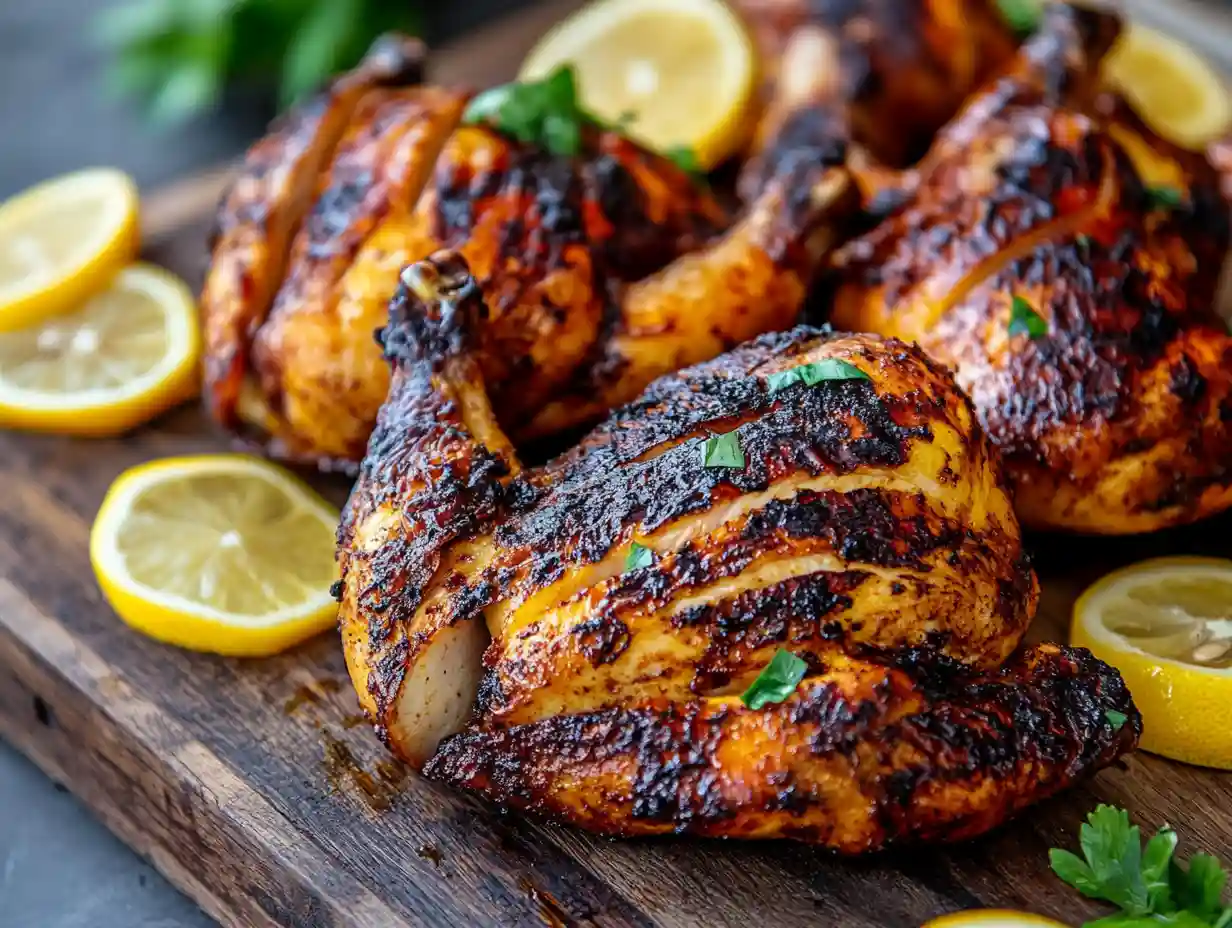Brine chicken recipe is truly a game-changer for anyone looking to elevate their poultry dishes. Not only does it add moisture, but it also intensifies flavor, making the right brine essential for achieving tender and delicious chicken. In this article, we will thoroughly explore everything you need to know about chicken brine recipes. From understanding the basics to discovering creative variations and useful tips, we’ve got you covered. Whether you’re a cooking novice or a seasoned chef, this comprehensive guide is designed to help you master the art of brining chicken and ensure perfect results every time.
Part 1: Introduction to Chicken Brine Recipe
Introduction to Brining Chicken Recipe
When it comes to cooking chicken, one method that consistently delivers moist and flavorful results is brining. Brining involves soaking the chicken in a saltwater solution, often with added sugars and spices, before cooking. This process enhances the chicken’s natural flavors and ensures it remains juicy, even after cooking. But what exactly makes brining so effective?
In essence, brining works through a process known as osmotic pressure. The salt in the brine solution breaks down some of the proteins in the chicken, which allows the meat to absorb and retain more moisture. As a result, the chicken is less likely to dry out during cooking. Moreover, brining can also infuse the chicken with additional flavors from the brine’s spices and herbs.
Benefits of Using a Brine for Chicken Recipe
Brining isn’t just a fancy cooking trick—it’s a tried-and-true method that offers several benefits:
- Enhances Flavor: A well-seasoned brine can infuse the chicken with delicious flavors, making each bite more savory and satisfying. Therefore, it’s a simple way to upgrade your meal.
- Increases Moisture Retention: By adding moisture to the chicken before cooking, brining helps prevent the meat from becoming dry, especially when using high-heat cooking methods like grilling or roasting. Consequently, your chicken stays juicy and tender.
- Improves Texture: Brined chicken tends to have a more tender texture, as the brine helps to break down muscle fibers, resulting in a more succulent bite. Thus, it ensures a more enjoyable eating experience.
For anyone eager to improve their cooking game, understanding and using a brine recipe can be a game-changer. It’s a simple yet effective technique that can elevate your dishes from good to great. So, let’s explore how to create the perfect basic chicken brine and the variations you can try to add a unique twist to your poultry dishes.

Part 2: Basic Chicken Brine Recipe
Ingredients for a Basic Chicken Brine
Creating a basic chicken brine is straightforward and requires only a few key ingredients. Firstly, consider the following essentials:
- Water: This is the main component of any brine. It helps dissolve the other ingredients, ensuring they mix well.
- Salt: Equally important for flavor and moisture, salt is a must. For best results, use kosher salt or sea salt.
- Sugar: Additionally, sugar adds a touch of sweetness that perfectly balances the saltiness. You can opt for either white or brown sugar.
- Optional Spices and Herbs: To enhance the flavor, customize your brine with optional spices like peppercorns and garlic, or herbs such as rosemary and thyme.
By incorporating these ingredients, you can create a brine that elevates the taste of your chicken.
Instructions for Preparing the Brine
Mix the Ingredients: First, combine water, salt, and sugar in a large bowl or pot. Stir until the salt and sugar are completely dissolved.
Add Spices and Herbs: Next, if you’re using any spices or herbs, add them to the brine mixture. This is where you can get creative and tailor the brine to your taste.
Cool the Brine: Finally, allow the brine to cool to room temperature before using it. This step prevents cooking the chicken prematurely.
How Long to Brine Chicken Recipe
Brining time varies depending on the cut of chicken:
- Chicken Breasts: Typically, brine for 30 minutes to 1 hour. This duration is enough to make them juicy without becoming too salty.
- Chicken Thighs and Drumsticks: Alternatively, brine for 1 to 2 hours. These cuts can handle a longer soak and still come out tender.
- Whole Chicken: For a whole chicken, brine for 6 to 12 hours. This longer brining time allows the flavors to penetrate deeply and keeps the entire bird moist.
Be cautious not to over-brine. Leaving chicken in the brine too long can make it too salty and affect the texture.
Quick Tips for Success
- Always use cold brine when adding chicken to avoid any bacterial growth.
- Ensure the chicken is fully submerged in the brine. If necessary, weigh it down with a plate.
- If you’re brining for more than an hour, keep the chicken in the refrigerator.
Mastering the basic brine recipe opens the door to experimenting with different flavors. Therefore, let’s move on to exploring exciting variations that can add a unique twist to your chicken dishes.
Part 3: Variations of Chicken Brine Recipe
Herb-Infused Brine Recipe
For a fresh and aromatic twist, try an herb-infused brine. Here’s what you’ll need:
- Ingredients:
- 1 cup water
- 1/4 cup kosher salt
- 2 tablespoons brown sugar
- 2 cloves garlic, smashed
- 1 sprig rosemary
- 1 sprig thyme
- Preparation Instructions:
- First, combine water, salt, and sugar in a pot. Stir until dissolved.
- Next, add garlic, rosemary, and thyme.
- Then, bring to a boil, and let it cool to room temperature.
- Once cooled, use it to brine your chicken.
This herb-infused brine works well with chicken breasts or thighs, adding a subtle, fresh flavor.
Citrus Brine Recipe
If you prefer a zesty flavor, consider a citrus brine. You’ll need:
- Ingredients:
- 1 cup water
- 1/4 cup kosher salt
- 2 tablespoons honey
- 1 lemon, sliced
- 1 orange, sliced
- 1 tablespoon black peppercorns
- Preparation Instructions:
- Combine water, salt, and honey in a bowl. Stir until dissolved.
- Then, add lemon, orange, and peppercorns.
- Chill the brine before using it.
This brine is great for grilling, adding a bright, tangy flavor to your chicken.
Spicy Brine Recipe
For a kick of heat, opt for a spicy brine. Gather these:
- Ingredients:
- 1 cup water
- 1/4 cup kosher salt
- 2 tablespoons brown sugar
- 2 tablespoons hot sauce
- 1 tablespoon crushed red pepper
- Preparation Instructions:
- First, combine water, salt, and sugar in a pot. Stir until fully mixed.
- Afterward, add hot sauce and crushed red pepper.
- Allow to cool before using.
This brine is perfect for spicy chicken lovers, giving your chicken a bold, fiery taste.
Sweet Brine Recipe
For a hint of sweetness, try a sweet brine. Here’s how:
- Ingredients:
- 1 cup water
- 1/4 cup kosher salt
- 3 tablespoons maple syrup
- 1 teaspoon cinnamon
- Preparation Instructions:
- Mix water, salt, and maple syrup in a bowl.
- Stir in cinnamon.
- Cool the brine before using it.
This sweet brine pairs well with chicken roasted in the oven, adding a lovely caramelized flavor.
These brine variations can make your chicken dishes stand out. Thus, experiment with these recipes to find your favorite. Following that, we’ll explore some essential tips and tricks to ensure your brining process is flawless.
Part 4: Tips and Tricks for Chicken Brine Recipe

Common Mistakes to Avoid
Brining chicken can be easy if you avoid these common pitfalls:
- Incorrect Salt-to-Water Ratio: Too much salt can make the chicken overly salty. Stick to the recommended measurements in your brine recipe.
- Not Cooling the Brine: Always cool the brine before adding the chicken. Hot brine can start cooking the chicken, which affects texture.
- Brining Time Mismanagement: Don’t brine the chicken for too long. Over-brining can lead to a salty taste and mushy texture. Follow the recommended brining times based on the cut of chicken.
How to Store Brined Chicken Recipe
Storing brined chicken correctly is essential for maintaining its quality. Here’s how to do it properly:
Refrigeration Guidelines: Firstly, always keep brined chicken in the fridge if you’re not cooking it right away. This practice helps prevent bacterial growth and keeps the chicken fresh.
Freezing Brined Chicken: If you need to store brined chicken for a longer period, you can freeze it. Just make sure it’s well-sealed in an airtight bag or container. When you’re ready to cook, thaw it in the fridge before use.
Adjusting Brine Recipes for Dietary Restrictions
If you have dietary concerns, adjusting brine recipes is straightforward:
Low-Sodium Alternatives: For a healthier option, use less salt or switch to a low-sodium salt substitute.
Sugar-Free Options: Similarly, substitute honey or maple syrup with a sugar-free alternative if you’re watching your sugar intake.
These tips and adjustments can help you make the most out of your brining experience. With these tricks up your sleeve, your chicken will be perfectly brined every time. Consequently, let’s look at how to cook your brined chicken to achieve the best results.
Part 5: Cooking Brined Chicken Recipe
Recommended Cooking Methods
Brined chicken is versatile and can be cooked in various ways. Here’s how to do it best:
- Grilling: Preheat your grill to medium-high heat. Place the brined chicken on the grill and cook, turning occasionally, until the internal temperature reaches 165°F (74°C). Grilling adds a nice char and smoky flavor.
- Roasting: Preheat your oven to 375°F (190°C). Place the brined chicken in a roasting pan and cook for 25-30 minutes, or until the internal temperature reaches 165°F (74°C). Roasting gives a crispy skin and juicy meat.
- Pan-Seared: Heat a skillet over medium-high heat. Add a small amount of oil, then sear the brined chicken for 5-7 minutes per side, until golden brown and cooked through. Pan-searing adds a rich, savory crust.
How Brining Affects Cooking Time
Brining can impact how long your chicken takes to cook:
- Adjustments Based on Brine Type: If you use a sweet or spicy brine, cooking times might be slightly different due to the sugar or spices. Keep an eye on the chicken to avoid burning or overcooking.
- Temperature Monitoring: Specifically, always use a meat thermometer to check the chicken’s internal temperature. This way, you ensure it’s fully cooked and safe to eat. For reference, the target temperature is 165°F (74°C).
By following these cooking methods and tips, you can make the most of your brined chicken. It will be flavorful and perfectly cooked every time. So, let’s move on to answering some frequently asked questions about brining chicken.
Part 6: Frequently Asked Questions (FAQs)
What is the best ratio of salt to water for brine?
The ideal ratio is typically 1/4 cup of salt for every 1 cup of water. By using this ratio, you ensure that the chicken absorbs enough flavor while avoiding an overly salty taste.
Can you over-brine chicken?
Yes, indeed. Over-brining can result in chicken that is too salty and may alter its texture. Therefore, it’s important to adhere to the recommended brining times to achieve the best results.
How long should I brine chicken recipe for different cuts?
- Chicken Breasts: Generally, brine for 30 minutes to 1 hour. This timeframe is sufficient for them to become juicy without being overly salty.
- Chicken Thighs and Drumsticks: On the other hand, brine for 1 to 2 hours. These cuts can benefit from a longer brine for better flavor and tenderness.
- Whole Chicken: For a whole chicken, brine for 6 to 12 hours. This longer duration allows the brine to penetrate deeply, enhancing the flavor and moisture.
Adjust the brining time based on the cut of chicken to ensure optimal flavor and texture.
Can I use a brine recipe for other meats?
Yes, you can! In fact, brine works well with other meats like pork or turkey. Just remember to adjust the brine recipe according to the type of meat you’re using.
How do I know if my chicken is properly brined?
The chicken should be juicy and flavorful. However, if it tastes too salty or dry, you might have over-brined it or used too much salt.
In addition, these answers should help you get the most out of your brining process. Consequently, let’s wrap up with a quick recap and some final tips.
Part 7: Conclusion
Recap of Key Points
Brining chicken is indeed a simple yet effective way to enhance both flavor and moisture. To summarize, here’s a quick review of what we’ve covered:
- Benefits of Brining: Primarily, it makes chicken juicier and more flavorful.
- Basic Brine Recipe: This includes water, salt, sugar, and optional spices.
- Variations: For a twist, you might want to try herb-infused, citrus, spicy, or sweet brines. Additionally, each variation adds a unique flavor profile, therefore allowing you to achieve different and exciting tastes.
- Tips and Tricks: Furthermore, avoid over-brining, store the chicken properly, and adjust the brine for dietary needs.
- Cooking Methods: Lastly, grill, roast, or pan-sear brined chicken to achieve the best results.
By following these guidelines, you can ensure your chicken is perfectly brined and delicious every time.
Encouraging Readers to Try Brining
Now that you know how to brine chicken, give it a try! Experiment with different brine recipes and cooking methods. Share your results and enjoy the delicious, juicy chicken you create.
Feel free to ask any questions or share your cooking experiences. Moreover, happy brining, and in the meantime, enjoy your delicious, juicy chicken!
